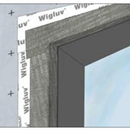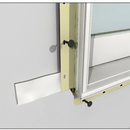Flashing a Flanged Window with Sealant and Tape
I’m installing flanged windows in my addition in Maine, zone 6A. Marvin G2 Ultimate double hungs to best match historic windows.
The windows have fold-out nailing flanges that don’t extend to the corners. There are “corner gaskets” that are included with the window install kits but they appear rather chintzy. Since the flanges are not continuous to the corners the sealant placement would stop 3/4″ before the corners (ref. attached Marvin pic). I’m struggling to see the value in installing discontinous sealant under the nailing flange. Should I just diligently tape with my Siga Fentrim over the installed flange and skip the sealant (ref. pic)?
Other details:
*fully Siga tape flashed 2″ wood bucks on zip sheathing
*sloped sills with back dam
*will have 2″ polyiso and rain screen
GBA Detail Library
A collection of one thousand construction details organized by climate and house part












Replies
Steve41
Just follow the manufactures instructions. Just make sure you wrap the tape up the sides of the jambs as they show. Otherwise, the fold out fins will leak.
Steve41,
eust's answer is the correct one.
It is not uncommon in my cold neck of the woods that nailing fin corners get broken off before or during installation (-25 C is brutal for vinyl)
Tape to the jamb.
Edit about the sealant. I don't know what corners Marvin supplies but I assume it is just functioning as a substrate for the sealant.
Thanks eust2023 and 5Stud - much appreciated. I do typically go with the manufacturers instructions in most cases, because after all it's their product and warranty.
I'm fighting logic on this one though regarding the sealant / corners. Key #1 with water / air is continuity. Applying sealant to within 3/4" of the upper corner (which would be the most leak susceptible area near the head) and then stopping, installing the window, and applying a "corner gasket" over the top doesn't seem robust. These gaskets are similar in stickiness to painters tape, perhaps much less. I have little confidence in their long-term performance and they would detract from the subsequent over-flange tape flashing.
It appears Marvin allows substitution of flashing tape for lost corner gaskets (attached pic from Marvin). I think I'll lose mine and go with Siga product. I'll run some sealant under the top/side flanges.... but in my view, since the sealant stops at the corners, it may as well not even be there.
Any other opinions / standard practice for the fold-out flange windows?
Thanks again.
I still use the manufacturer-recommended sealant but agree that it's probably doing little to nothing. I use a high-quality flashing tape and lap it over the nailing fin and onto the window frame. I do not seal the bottom fin with sealant or tape, instead allowing it to drain if necessary. I've even had one architectural rep for a major manufacturer (not Marvin) agree with me but in case of a warranty issue, he recommended including the caulking.
Thanks Michael - This is exactly what my approach will be.
I kind of do both. Caulk the bottom but with gaps.
I used to do that as well, but Christine Williamson convinced me to transition the air control layer to the window interior so the exterior only needs to be watertight. With a rainscreen gap, no water should be able to get up under the lower flange. But there's probably no harm in sealing it as long as there are weep holes.
If you are covering the flange with flashing tape, I'm not sure that in practice that caulking anywhere does anything useful.
When you install a window you set it on the sill, tilt it into place, then invariably have to move it laterally to square it up in the opening. If you have ever had to take the window out at that point, you can see the caulking is all over the place, and looks nothing like the neat bead shown in diagrams.
I do it if it is in the installation instructions. Otherwise I don't.
Belt and suspenders...
Sealant under the flanges + Tape over.
You may not be sealing under 100%, but you're getting at least 80%+.
briancornwell,
Or maybe belt, suspenders, and the pants glued to your waist. The joint is protected by
- The lined RO
- The flange itself
- The WRB
- Flashing tape.
- A rain-screen gap
- Cladding and trim
I don't like adding layers if they aren't adding appreciable benefit. The only place I'll concede it might be of some help is at the head - but even there the caulking is best placed between the head-flashing and flange.
FWIW, the installation instructions for Marvin's Essential windows with the fold out flanges make no mention whatsoever of using sealant under the flange. I've really been scratching my head about it until now, but you all raise a lot of good points as to why it might be counter productive.
Marvin seems to be mostly concerned with water getting through the seam where the flanges connect to the window, which would bypass sub-flange sealant anyway.
https://www3.marvin.com/WebDoc/Essential%20Window%20Installation%2019970123.pdf